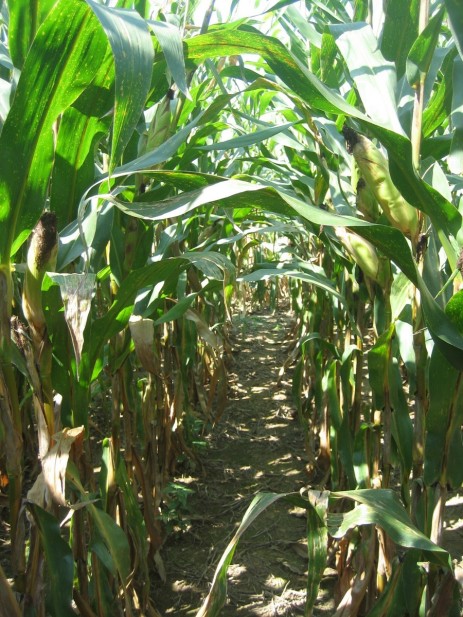July 9, 2018

By Alyssa Collins and Paul D. Esker
The question of the benefit of fungicide applications at a V5-V7 timing comes up a lot. It’s an attractive option because at that time the corn is short enough to be easily driven over with most equipment, and most farmers are used to applying an herbicide at this time as well. This means you do not need to deal with the hassle and expense of getting a custom applicator to make the application. Because of this, university plant pathologists across the country have studied this question for several years. In the majority of studies, we have found no significant yield benefit to a fungicide application at this early vegetative timing.
The challenge is that our primary yield-limiting diseases do not become problematic until the reproductive stages of development. This is for several reasons.
the fungal leaf diseases that are most yield-robbing are favored by warm temperatures and high humidity. At the earlier growth stages like V5-V7, the crop canopy is very open with excellent air flow. It is not until later stages that the canopy closes over, trapping in heat and humidity. If you have ever scouted corn, you know exactly what we mean!
the leaves that really do the work of grain fill (the ear leaf and above) are not yet formed at this time. Because of this, we cannot protect them with an early fungicide application. Even our most persistent fungicides only last for about three weeks in the plant tissue.
the fungi that cause diseases like Grey Leaf Spot (GLS) and Northern Corn Leaf Blight (NCLB) survive in crop residue from previous years. It takes some time each season for conditions to become right for them to start sporulating, and then for those spores to leapfrog from the lowest leaves to the upper, more critical ones.
In general, the vast majority of studies have found the greatest yield benefit from a fungicide application at VT-R1. This makes sense, because this is typically a time of high disease pressure and the tissues we want to protect most are present and functioning at this time. The ear leaf and those leaves that are younger are the solar panels that provide the plant the energy and sugars that then fill the grain. These later applications take us further into the season with protection of this foliage. This can be critical not only for those growing for grain, but also silage producers. The downside of the VT fungicide timing is that it requires specialized equipment like a highboy or aerial application, which is more expensive and needs to be scheduled with a custom applicator. However, if a farmer is only going to make one fungicide application, this should be the one, as it traditionally provides the biggest bang for the buck. Some farmers have taken this further by following a VT application about two or three weeks later with a second treatment with good results in high disease pressure situations. Those considering this should be careful to watch the pre-harvest interval restrictions, especially when chopping silage.
To be clear, we are not saying that there is never a situation in which an early season fungicide treatment provides a yield advantage. We look at corn disease risk as the culmination of several factors. The more of these factors are at play in your field, the greater the benefit you can realize from a fungicide at any timing.
For example, if you have:
continuous corn
no-till production
greater than 30% corn residue
extended warm, humid weather
low lying field, where dew tends to persist
irrigation
a hybrid with a poor resistance rating for GLS or NCLB
high yield potential
disease already present at the time of scouting
…then you stand to gain the most from a fungicide treatment.
For instance, earlier this season, we received a call from an extension educator who was working with a farmer experiencing anthracnose on V4 corn. Because the season was so wet for so long in our region, with no signs of abating, the question of an early fungicide application was warranted. When I learned that this field was also corn-on-corn, no-till, a susceptible hybrid, and irrigated, these were enough factors to recommend that the grower pull the trigger on an early fungicide application in this case.
So is there ever any drawback to throwing in a fungicide at V5 if you’re going across the field with an herbicide at that time anyway? Well, apart from the added expense, there is a good chance we would be encouraging fungicide resistance among the fungi that are in that field. Whether or not they are causing disease at the time, the pathogens are present in that residue, and any exposure to our most common active ingredients nudges their populations closer to becoming resistant to these products. Our current fungicides work well and are pretty safe for humans and the environment. We’d like to keep these tools around for our use as long as possible.
For more information about fungicides and their efficacy for managing corn foliar diseases, see this Crop Protection Network article .
Source: Penn State University
You May Also Like




